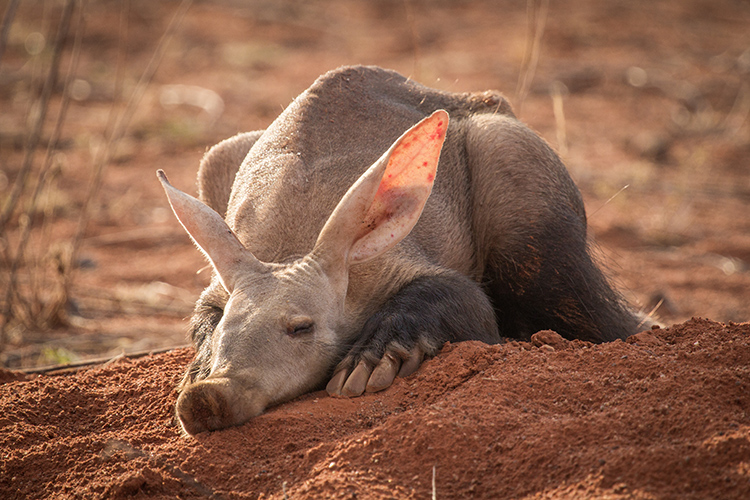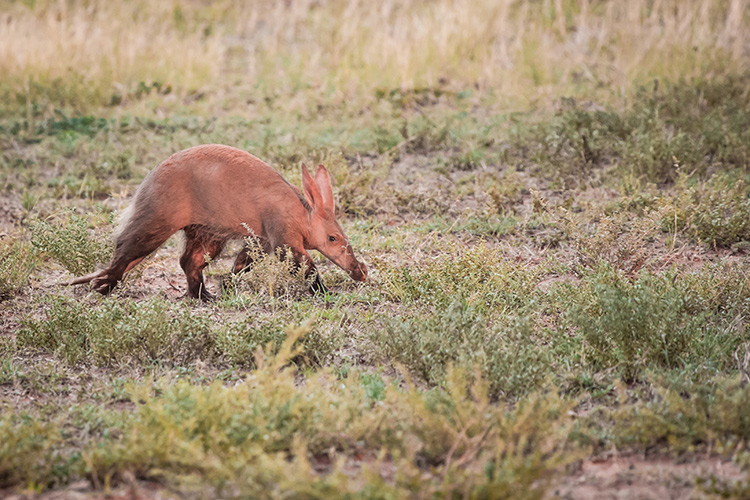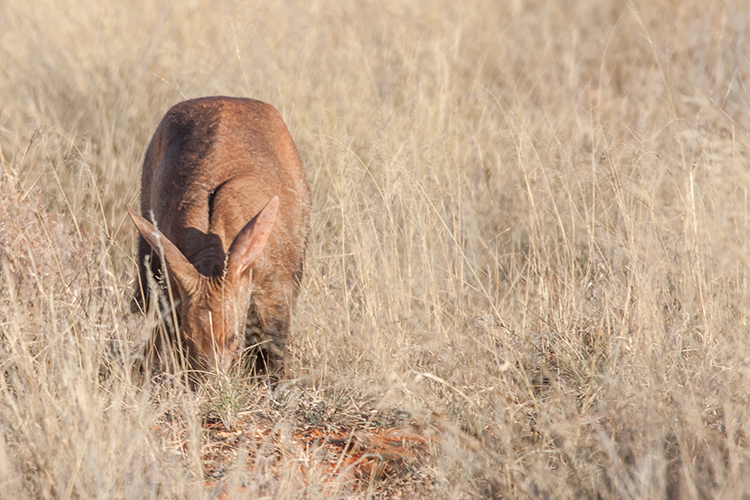Aardvark encounter in the Southern Kalahari
Posted by Marco Tonoli
in Africa
For the seasoned African traveller, it is commonly known that the Aardvark (Orycteropus afer) is possibly one of the least seen animals in the bush. Frequent jests are made to experienced guides that the quest for an afternoon game drive should be to see an Aardvark, while it is generally understood that the chances are close to zero. However, in the right environment, not only are these elusive creatures a regular sighting, but you have the opportunity to view some of their behavior. This can easily put into context the ecological contribution this animal plays in its environment.
The Latin name for this animal is most fitting and descriptive of its general behavior. “Orycteropus” means “burrowing foot” and “afer” is an adjective form of Africa. This most bizarre creature appears somewhat like a rat, with huge tubular ears like that of a donkey, a long stout pig-like nose and claws like a bear. The Aardvark’s powerful limbs and claws make this mammal an exceptional digger. Huge holes and burrows are dug in the search for food. The burrow systems of an Aardvark can be extensive, reaching depths of up to 10 feet (3 meters) deep. Although the entrance to these burrows are often just large enough for the Aardvark to fit through, the systems extend up to 30 feet (10 meters) and branch into several tunnels that end in a slightly larger sleeping chamber. On entering the burrow in the early hours of the morning to take refuge and sleep, the smaller entrance is partially closed with loose sand, which prevents other creatures from entering while still allowing for a flow of air into the burrow.
Most of the night is spent searching for food. Sniffing the ground in search of their prey, they plod along with ears erect to listen for danger. And if no danger is detected, they merrily continue going about their business.
Aardvarks sniff out termites by digging small excavations and then putting their nose flat on the ground. When termites are discovered, the Aardvark viciously begins digging into the soil to find the nest and then proceeds to lick up the termites with its long, sticky and flexible tongue. The termites stick to the wet surface of the tongue and are quickly lapped up.
It is this continuous search for food and their exceptional digging capabilities that provides their indirect contribution to many other species. With its strong claws, Aardvarks can easily and aggressively break and penetrate the hard crust of the Snouted Harvester Termite (Trinervitermes trinervoides) mounds. During cold months, the availability of above ground termites such as the Harvester Termites (Hodotermes hadotermes) are very scarce and Aardwolf (Proteles christatus) can often be seen following Aardvark to feed at termite mounds once the Aardvark has left. The following day, Ant-eating Chats (Myrmecocichla formicivora) also utilize the open termite mounds to feed on the left over dead termites scattered around.
Not only does the Aardvark facilitate the supplementary feeding of other species during the harsh winter months, but old excavated mounds may also be utilized by various species as hideouts. Termite mounds that have been opened by an Aardvark provide a safe refuge for many species, especially if the mound has been “cleaned out” by an Aardvark and no longer houses termites. With cold winter nights and scorching summer days, an underground refuge is vital to the survival of many desert species. Nesting within the mounds provides a safe microclimate, especially for the small shrews that are sensitive to temperature changes. The burrows are also utilized by many species who are often unable to make their own, including the Ant-eating Chat, jackal, hyena, warthog, Aardwolf, mongoose, Black-footed Cat and porcupine. In fact, as many as 17 species of mammals utilize Aardvark burrows and the survival of some of these species may depend on the shelter these burrows provide.
Although it is probably one of the least seen animals in the bush, one can now easily understand how important a role the Aardvark plays in its environment. This night-time footage was captured while we were out on a game drive in the Southern Kalahari. This individual first dashed across the road and then bolted down a hole. We approached the entrance to the hole not more than 6 feet (2 meters) away to listen to his digging activity, when it appeared at some point he had forgotten we were there. With the wind in our favor, This Aardvark gave us a fantastic opportunity to view it up close.
The Southern Kalahari is probably one of the best place in Africa to view Aardvarks. Join Marco on our Secret South Africa expedition for the opportunity to view this bizarre and elusive animal for yourself!




So cool!! Love watching this critter. Most unusual looking!! It looks large in the video. I’m very impressed with the “show” he put on for you. Great work. Thanks so much Marco.
Great video. Sorry to miss the Uganda trip this year.
Marco, I loved watching this Aardvark video, thank you for sharing. Your efforts to keep your fellow travelers engaged during this past year have been amazing! Can’t believe it was one year ago that we were in Ethiopia together with Liam.
Looking forward to the next adventure.